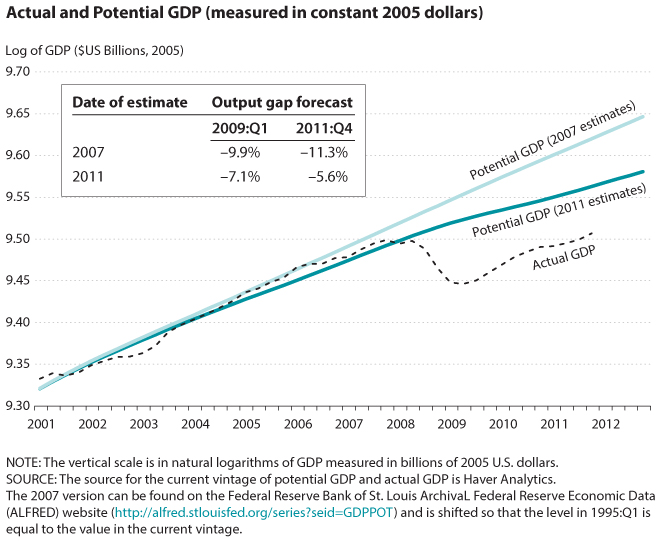What Is Potential GDP and Why Does It Matter?
Potential gross domestic product (GDP) is a theoretical concept that means different things to different people. To some, it reflects a world in which every worker is matched with the perfect job, every good idea is implemented, and the bad ones are ignored. In this world, resources are allocated optimally with no distortions from the tax code, information frictions, or suboptimal government policies.
But this theoretical "perfect world" is not the real world, and the scenario just described is not the concept of potential GDP monetary policymakers typically use when setting monetary policy. Instead, they estimate potential GDP by constructing measures of the trend in actual GDP that smooth out business cycle fluctuations. Looking back in time, potential output is relatively easy to measure because we have reliable methods to extract smooth trends from historical data. However, measuring potential output in real time is more difficult because only past data are available to estimate the trend. We cannot be confident about the estimate of potential GDP for 2012 until several years have passed and we see how GDP evolves—the accuracy of our estimate depends on the accuracy of our long-term forecast.
But why does potential GDP matter? How do we use it? Potential GDP is important because monetary policymakers use the difference between actual and potential GDP—the output gap—to determine whether the economy needs more or less monetary stimulus. One look at recent Congressional Budget Office (CBO) data shows how much estimates of the output gap can change as time passes. According to CBO estimates of potential GDP, U.S. actual GDP fell about 10 percent short of potential during 2009:Q1. Since then, actual GDP has paralleled the potential GDP series forecast made by economists back in 2007—but, of course, along a considerably lower level path. The chart shows logged values of actual GDP and two estimates of potential GDP calculated by the CBO. The higher level of potential GDP was estimated in 2007 and the lower level in 2011. The reduced 2011 estimate reflects the impact of sluggish GDP growth over the past three years.

Based on revised estimates, we can now calculate the 2009:Q1 output gap to be –7.1 percent. Even more interesting is how the revision affects estimates of the output gap for 2011:Q4. If we use 2007 estimates, the output gap for 2011:Q4 would be –11.3 percent. When we use up-to-date estimates, the gap is much smaller: only –5.6%. Potential GDP is likely to be revised downward again if (i) growth remains moderate—say, less than 3 percent—and (ii) inflation continues to edge upward.
Continued moderate growth of GDP is forecast over the next few years. In the minutes of the January Federal Open Market Committee meeting, the participants projected, on average, that real GDP would grow about 3 percent over the next three calendar years. This growth rate is too slow to get GDP back to current estimates of the trend. If the projections hold true, the estimates of the level of potential GDP will fall even further. This pessimistic outlook is also supported by Keynesian (and New Keynesian) theory, which predicts that a negative output gap should lead to falling inflation. But instead, we have seen a modest rise in inflation. If the theory is correct, the gap may be closing faster than we thought because potential GDP is lower than we thought. And, if potential GDP is lower than expected, then interest rates may have to rise sooner than expected to prevent an acceleration of inflation.
© 2012, Federal Reserve Bank of St. Louis. The views expressed are those of the author(s) and do not necessarily reflect official positions of the Federal Reserve Bank of St. Louis or the Federal Reserve System.


 follow @stlouisfed
follow @stlouisfed